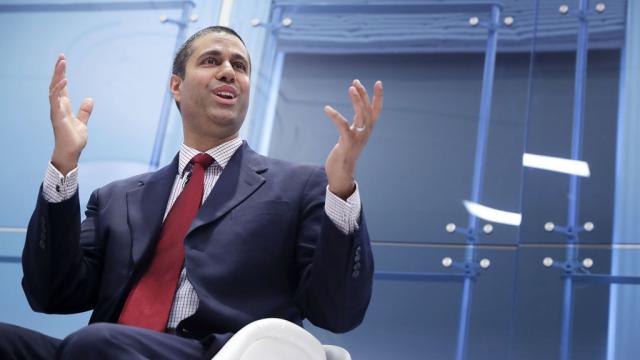Last week, we reported that tens of thousands of fraudulent comments had been filed in favour of FCC chairman Ajit Pai’s proposal to roll back net neutrality rules in the US, using text taken from the Center for Individual Freedom (though, according to the CFIF, they aren’t behind the fake comments). We spoke to several people who had comments filed under their names and addresses, as did reporters from other outlets, and several more supposed commenters responded to our emails after publication saying they hadn’t filed comments with the FCC.
Image: Getty
But the coverage hasn’t deterred whoever is filing these fake comments, which have ballooned. On Wednesday last week, 128,000 of these particular identical comments, beginning, “The unprecedented regulatory power the Obama Administration imposed on the internet…” had been filed. Now, that number is up to more than 440,000, with the most recent comments filed on May 12. (The FCC doesn’t consider comments submitted in the week leading up to a vote on the notice of proposed rulemaking, which will happen May 18.)
And two blog posts published this weekend may provide more evidence that a bot is being used to file these comments.
One, published on Medium by Chicago-based developer Chris Sinchok, looked at the sources of the comments. (Sinchok formerly worked at the Onion, another property of Univision, Gizmodo US’ parent company.) Sinchok filtered the comments for ones filed directly to the FCC’s site — which would also account for commenters directed from gofccyourself.com, John Oliver’s site — and those filed through the FCC’s API, which is essentially a tool used to interact with or communicate with a program or database. (Sinchok later clarified in an email that he missed a third source of comments, those filed in bulk by a CSV file, which he said numbered 277,959 as of yesterday morning local time. Those comments, he said, would be “even easier to fake”.)
Sinchok found that comments filed through the site itself were “pretty similar” to each other, mostly using phrasing similar to what John Oliver suggested, but also had “a ton of variation”. Sinchok concluded that if there was any significant bot activity for messages filed through the site, “they’re doing a good job of disguising it”. The most common on-site comment text was filed around 14,000 times; the rest of the top five most common comments were filed several thousand times each, and all were pro-net neutrality.
Compare that to comments filed by API, where the most common comment text has been filed 436,000 times. The next most common comment text has been filed 181,000 times, and appears to come from Free our Internet, a non-profit staffed by a Trump campaign staffer from Maine and the spokesperson for Breitbart News Network. Its website says Obama “gave away our internet” with the net neutrality order, “at the behest of radical leftists and globalists like George Soros”. Another, from the Taxpayers Protection Alliance, which gets funding from Koch brothers-funded groups, has been filed 96,000 times. The only pro-net neutrality comment filed en masse by API has been filed 24,000 times.
Sinchok also identified a second stat — filing a comment through the FCC site gives the commenter the option to request a confirmation of their comment, but the overwhelming majority of the CFIF “unprecedented…” comments recorded no data for email confirmation. That seems to suggest those comments came from a bot using other people’s email addresses — why would they want to alert those people their addresses were used with an email confirmation? Meanwhile, pro-net neutrality comments filed through Battle for the Net mostly did opt to receive email confirmation.
Another post, by Jeffrey Fossett, a data scientist who previously worked for Airbnb, supports Sinchok’s analysis. Fossett’s chart shows the bot comments arriving in huge numbers, and then disappearing for hours at a time:

Image: Jeffrey Fossett.
Fossett also has some conclusions about how many genuine comments have been filed to support Pai. After removing the supposed bot comments, he took a random sample of 200 real comments and categorised all of them by whether they supported or opposed net neutrality. He found, unsurprisingly, an overwhelming majority of 95.6 per cent in favour of keeping net neutrality rules.

Image: Jeffrey Fossett.
This is more evidence of what was already quite clear: Someone is seeking to tip the scales of the FCC comment process more in favour of Pai’s proposal. So what is the FCC going to do about it? When it comes to vote on the rules, will it consider these fraudulent comments as if they were legitimate, equal to the real comments filed by members of the public? And will it investigate who filed so many comments in other people’s names?
Mark Wigfield, a spokesperson for Pai’s office, declined to comment.
